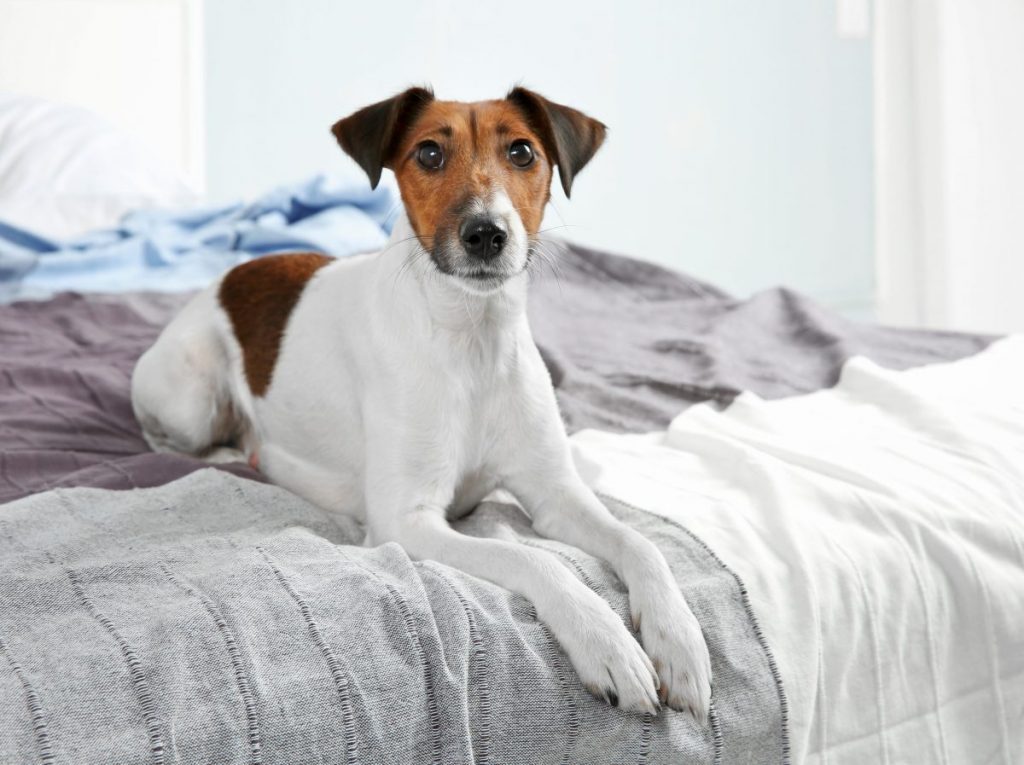There can be many reasons for your dog peeing on your bed, such as anxiety, the need for them to mark their territory, or an infection. It’s important as an owner to understand the potential underlying cause or causes. While it’s easy to blame your pet for the unpleasant accident, oftentimes there are steps you can take as an owner to stop the act before it happens.
Reasons Why Your Dog Pees On Your Bed
So before you scold your dog after his next accident, consider the possible reasons outlined below.
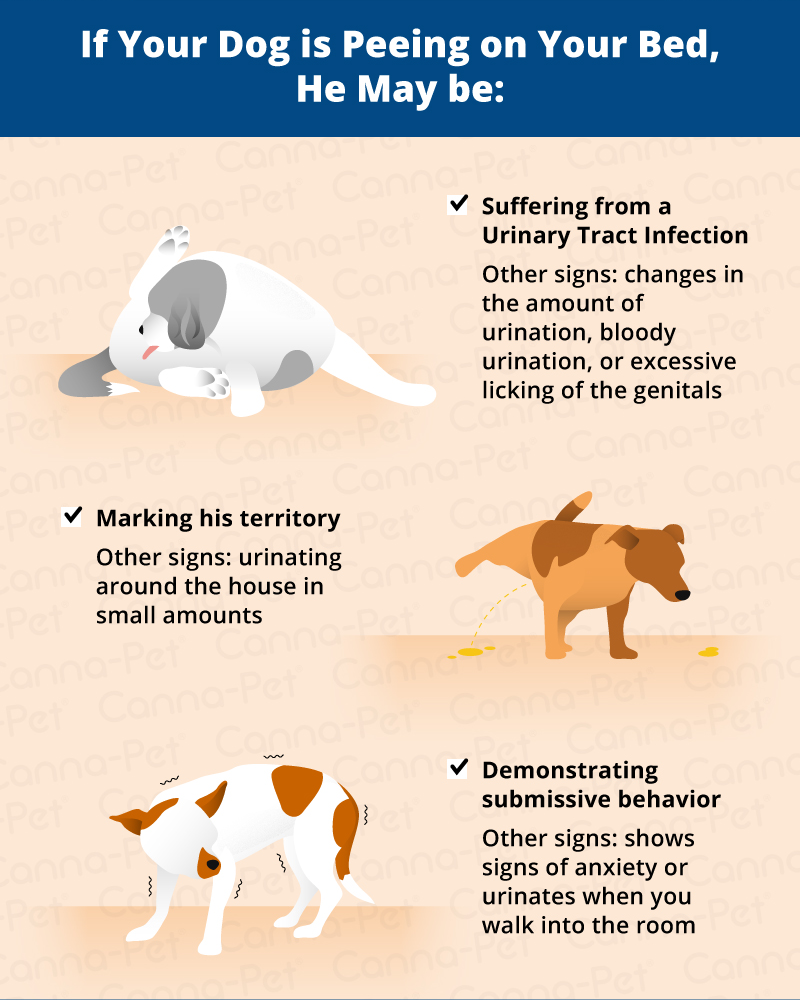
Urinary Tract Infection
Urinary Tract Infections (UTIs) commonly cause a lack of urination in humans; however, dogs can actually experience the opposite effects. In fact, oftentimes when dogs have a bladder infection they break their housetraining through frequent urination.
If your dog is typically well behaved while you’re gone, but you start to see this habit arising, a bladder infection could likely be the cause. Some common signs of urinary tract infections in dogs include a lack of or excessive urination, blood in urine (typically displays in a pinkish color), obsessive licking of the genital area, breaking housetraining, and dribbling urine.
Marking Territory
If you have always struggled with your dog peeing on your bed, the need to mark his territory could be an alternative explanation. A telling sign of territory marking is if your dog is urinating in multiple places around your house in small amounts. This is generally a habit that male dogs acquire, though that does not mean that female dogs cannot exhibit similar behavior.
The reason dogs mark their territory is fairly based on evolutionary principals. Your dog is likely attempting to claim the territory as their own or leave their scent behind as a “calling card” for mating purposes. Marking often starts in a dog’s adolescence years and then increases in frequency once the dog becomes physically mature.
One way to reduce this tendency is by neutering or spaying your pet. Typically, if your dog is displaying these signs as a puppy it’s likely that territory marking is the main proponent behind his behavior.
Submissive Behavior
Some dogs are known as “submissive eliminators.” This means that they are naturally prone to be more fearful or anxious. Many owners find submissive dogs incredibly desirable because they are easier to train, obedient among children, and eager to please their owner.
However, when a dog becomes overly submissive, problems start to arise. In particular, submissive dogs typically develop a habit of urinating frequently. Whether this is when they are excited or frightened, submissive dogs view urination as a sign of respect. Signs of a submissive dog include urinating or squatting when you walk into the room.
The good news about overly submissive dogs is that this is typically a behavior displayed in young puppies and once your dog become more comfortable in his new environment, the behavior should diminish over time. Although, if you believe your dog may be submissive, be careful about how often you scold him for his behavior because this can lead to more frequent and unwanted urination.
How to Prevent Your Dog from Peeing On Your Bed
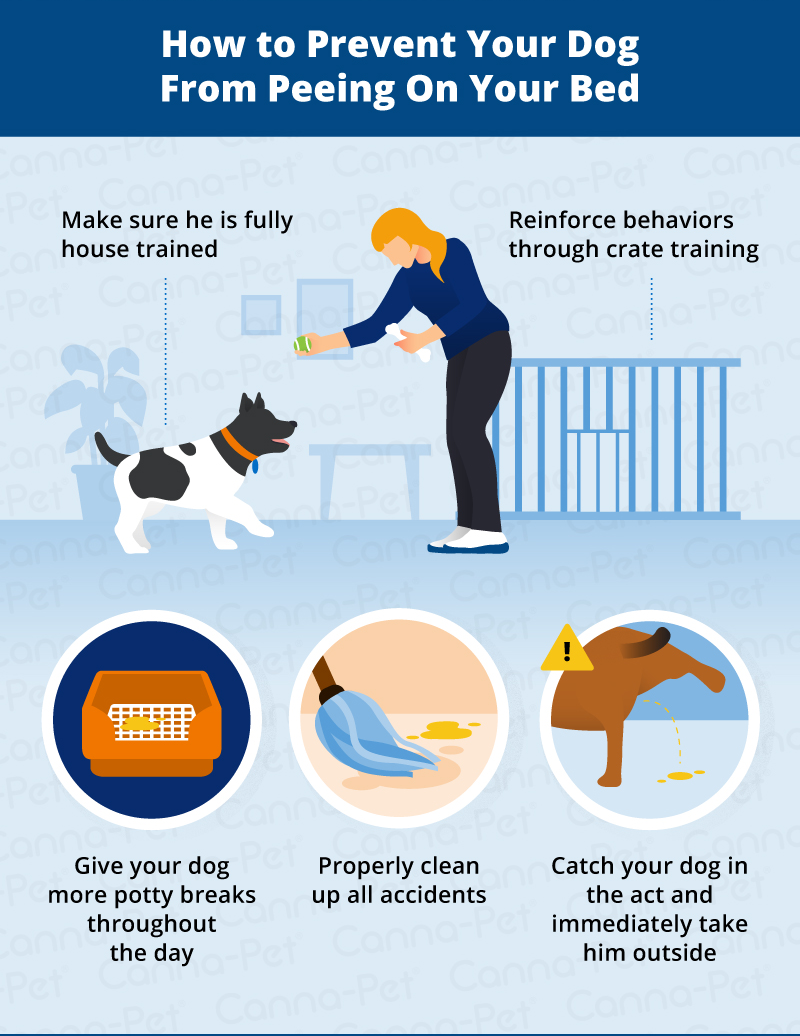
Give Your Dog Enough Opportunities to Go
If you typically have to leave your dog at home for long periods of time, it’s incredibly important that you give him enough opportunities to go to the bathroom. Some dogs have much smaller bladders than others, so it isn’t a matter of whether your dog is peeing on your bed for attention, but rather they cannot hold in their urine any longer.
If you have an enclosed backyard, consider installing a dog door that your dog can use to let himself outside while you’re away. If this isn’t an option in your home, consider purchasing dog-training pads that your dog can use.
Spend Time House Training Your Dog
If you see these habits translating beyond your dog’s adolescent years, your dog may not fully understand his housebreaking rules. In this case, your pet simply doesn’t understand where he is supposed to go to the bathroom.
If you think you may have not have succeeded in originally housetraining your pet, it is important to take training back to the basics in order to counteract this behavior. A great way to start is by blocking off areas that you’re seeing the accidents take place the most often.
This is especially important if you’re going to be leaving the house for more than a few hours at a time. Start by closing all bedroom doors and limiting your dog to one or two rooms of access and consider using ex-pens or crates.
Crate Train Your Dog
Crate training is not just for young puppies. When older dogs start to redevelop potty-training issues, crate training is an incredibly effective option for getting rid of this bad habit. While some owners see crate training as a punishment for dogs, it actually gives dogs more sense of security.
This is especially effective in anxiety-prone and older dogs. Not only does crate training help with potty training, it also prevents destructive behavior and teaches dogs how to settle and relax.
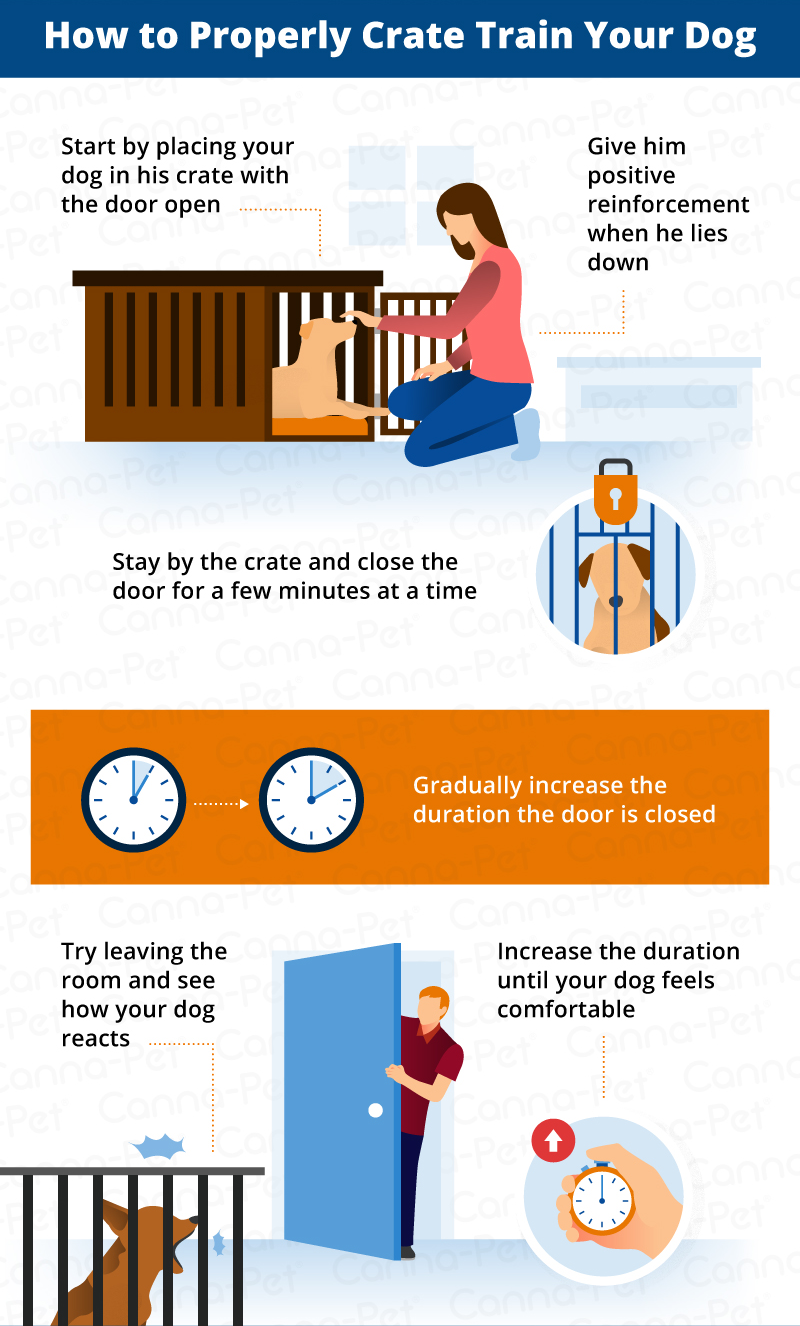
How to Properly Crate Train Your Dog
While the benefits of crate training are almost endless, it’s incredibly important to properly crate train your dog in order to see the full benefits. As an owner, you need to emphasize the praise in getting your dog to lie in his crate. This can be done through positive reinforcement, which teaches the dog that his crate is his own personal sanctuary, much like a child’s bedroom.
The crate should become a place where your dog can go in order to not be bothered, especially when he is tired or nervous. This becomes incredibly important when you leave your house for long periods of time because this is usually when your dog’s anxiety heightens. While you may see some resistance from your dog at first, once you get him in the habit of being in his crate, he will likely start going into it without being told.
In order to ease into this process, practice placing your dog in his crate with the door open for the first few times. This helps so your dog doesn’t feel trapped. Gradually increase the time you keep the door closed, but be sure to stay next to the crate so that your dog knows that he is okay. Once your dog seems to be relatively calm in this scenario, practice leaving the room where the crate is and see how your dog reacts.
It’s likely that your dog may start to whimper or bark at first, but eventually he will calm down. Try not to cave when you hear your pup cry because the more you return when he is unsettled, the more he will think that he will be able to get out of the crate without even attempting to settle.
How to Choose the Right Crate
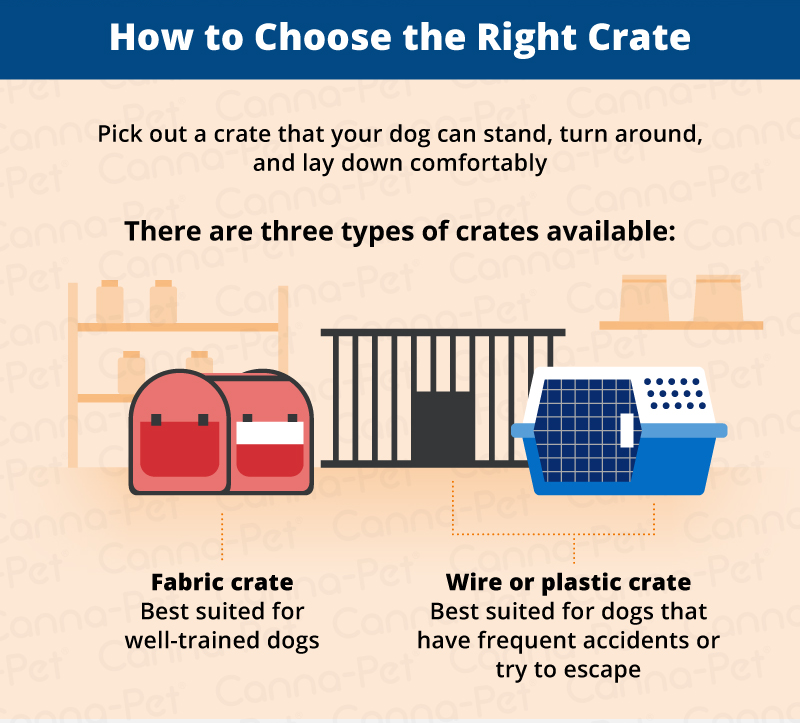
It can become quite a daunting task to pick out the right crate for your dog. With several different types of crates, sizes, and locations to put them in your home, as an owner it can be overwhelming to know what’s best for your dog. However, as a starting place the three most common types of crates are wire, plastic or fabric.
Fabric crates are great for small dogs to travel in, but are mostly suited for well-trained dogs. In the case that your dog is having accidents on your bed, a plastic or wire crate is a more practical option. Plastic crates are typically more secure, which makes dogs feel more comfortable and it makes it harder for “escape artists” to find a way out. Wire crates are easy for storage and are typically more inexpensive. Choosing between a wire or plastic crate can be left up to the owner as the differences are fairly minimal.
However, when it comes to the size of the crate, there should be less discrepancy in the decision process. You want to pick out a crate that your dog can stand in, turn around, and lay down comfortably. The mistake most owners make is that they buy too large of a crate because they want to make sure their dog has enough room to get comfortable.
This can often backfire and when dogs have too much space in their crate they can start using it as a bathroom. A great thing about wire crates is that most of them are adjustable so you can make the space smaller or larger depending on the size/growth of your dog.
As per crate location, if you are comfortable with this, you can keep the crate in your bedroom while your dog is first getting used to the space. If you don’t want to deal with the chance of being woken up in the middle of the night, place the crate in an open area like the living room. This will give you and your dog easy access to the space and in turn your dog will not feel as trapped if he can see his surroundings.
Properly Clean-Up All Accidents
One thing that dogs are particularly gifted with is their sense of smell. Unfortunately, this means that if your dog can smell his urine, he is more likely to urinate in the same spot again. To prevent an accident from happening again, clean up the urine using an enzyme-based pet odor/stain remover in order to completely get rid of the smell. In addition, make sure your sheets are regularly cleaned.
Dogs are not only drawn to their sent, but their owners’ as well. This makes them more likely to urinate on things (in this case your bed) that remind them of you. Though this may not be the way you prefer your dog to show his affection, he can’t help it. Puppies are especially likely to display this behavior because they are attempting to mask their scent from “predators” by disguising it in your sheets.
Catch Your Dog in the Act
While you may not be home when the accident occurs, if you happen to catch your dog in the act, he is much more likely to understand your anger at his behavior. So given the off chance that you are home, it is best to interrupt your dog with a loud noise (a clap of the hands works) when they start to pee indoors.
Immediately take him outside where he can finish peeing and then praise him with positive reinforcement when he finishes his business. In order for this process to work, you must never punish or yell at your dog for peeing inside. Dogs respond much better when positively rewarded for good behaviors than being punished for negative behaviors.
There are several reasons as to why your dog is peeing on your bed. It is important to be attentive to your dog’s behavior in order to better identify why these accidents keep happening. Through proper training and observation, this is a correctable habit for your dog.
So before you start scolding your dog, recognize as their owner you may need to take some of the responsibility. Though this can be incredibly frustrating and is the last thing you want to come home to after a day of hard work, don’t give up hope. It’s only a matter of time before your bed stays dry and you and your pup remain happy and healthy.
Sources:
- “Why Does My Dog Pee On My Bed? What Does It Mean?” Petsho, Accessed 29 June 2017. https://petsho.com/my-dog-peed-on-my-bed-what-does-it-mean/.
- Paretts, Susan. “Why Did My Dog Start Peeing On My Bed?” Cuteness. Accessed 29 June 2017. https://www.cuteness.com/blog/content/why-did-my-dog-start-peeing-in-my-bed.
- Barchas, Eric. “Why Is My Dog Peeing On The Bed? Taking A Look At Hormone-Responsive Urinary Incontinence”. Dogster, Accessed 29 June 2017. https://www.dogster.com/lifestyle/ask-a-vet-why-is-my-dog-wetting-the-bed.
- “Dog Pees On Bed”. AKC, 23 June 2015, Accessed 29 June 2017. https://www.akc.org/expert-advice/training/dog-pees-on-bed/.
- Turner, Callum. “Peeding On The Bed In Dogs”. Wag Walking, Accessed 29 June 2017. https://wagwalking.com/symptom/why-is-my-dog-peeing-on-the-bed.

